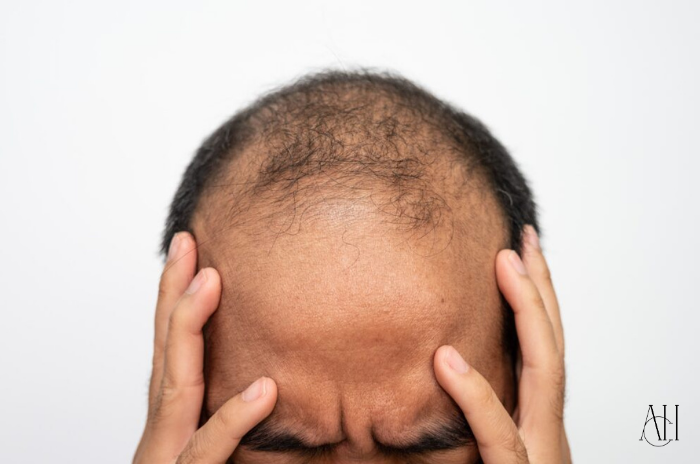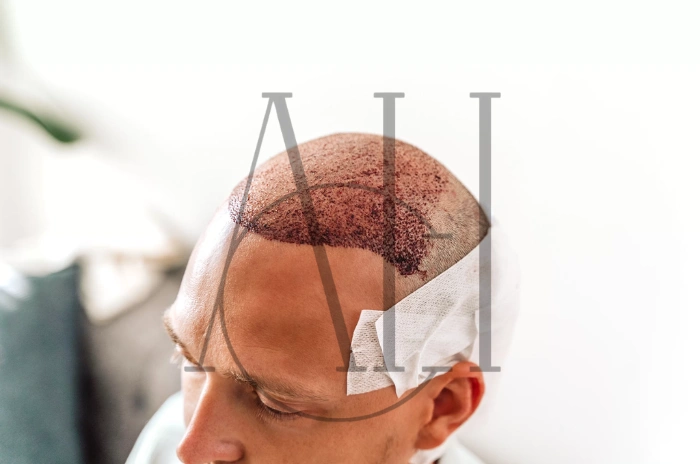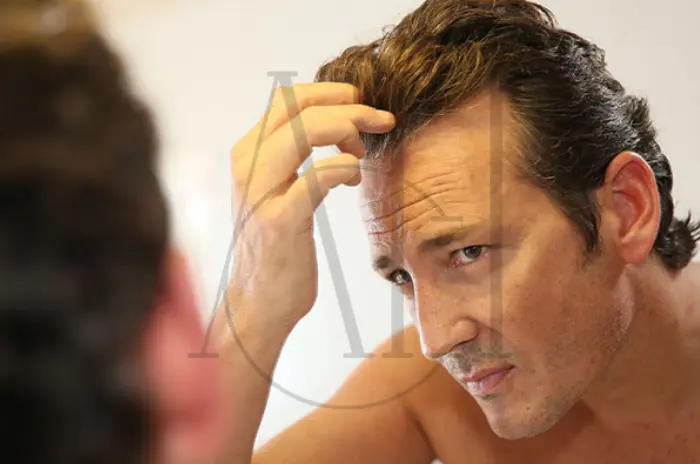Hair loss affects millions of people worldwide, and one of the most common yet misunderstood causes is stress. Can anxiety cause hair loss? The answer is yes, and understanding this connection is crucial for anyone experiencing unexpected hair thinning or shedding. Stress and hair loss share a complex biological relationship that can manifest in various ways, from gradual thinning to sudden patches of baldness.
When we experience prolonged or intense stress, our bodies release stress hormones like cortisol that can significantly disrupt the natural hair growth cycle. This disruption doesn’t happen immediately – it often takes weeks or months after a stressful event for hair loss to become noticeable. The good news is that stress-related hair loss is typically temporary and reversible with proper care and stress management. This comprehensive guide explores the intricate relationship between stress and hair loss, examining the biological mechanisms, different types of stress-induced hair conditions, and evidence-based solutions for prevention and treatment. Whether you’re dealing with sudden hair loss from stress or chronic thinning, understanding these connections empowers you to take effective action.
Table of Contents
ToggleCan Stress Cause Hair Loss?
Stress can indeed cause hair loss through multiple biological pathways that affect hair follicles at the cellular level. When we experience stress, our bodies release cortisol and other stress hormones that can push hair follicles into a premature resting phase, leading to increased shedding weeks or months later.
The connection between stress and hair loss isn’t just anecdotal – scientific research has identified specific mechanisms by which chronic stress disrupts normal hair growth patterns. These mechanisms involve hormone fluctuations, immune system responses, and behavioral changes that collectively contribute to various forms of hair loss.
How Stress Triggers Telogen Effluvium
Telogen effluvium represents the most common form of stress-related hair loss. This condition occurs when stress hormones force hair follicles to enter the telogen (resting) phase prematurely. Here’s how the process unfolds:
- Stress hormones like cortisol disrupt the normal hair growth cycle by shortening the anagen (growth) phase
- Hair follicles shift into telogen phase earlier than normal, causing widespread thinning
- The hair loss becomes noticeable 2-4 months after the initial stressful event or period
When Stress Leads to Trichotillomania
Trichotillomania is a stress-related condition where individuals compulsively pull out their own hair. This behavioral response to stress creates distinctive patterns of hair loss that differ from hormonal or immune-related causes:
- Stress and anxiety trigger the urge to pull hair from the scalp, eyebrows, or other body areas
- The resulting hair loss appears patchy and irregular, often with broken hair shafts
- Trichotillomania requires both stress management and behavioral intervention for effective treatment
Alopecia Areata: Stress and Immune Response
Alopecia areata involves an autoimmune response that can be triggered or worsened by stress. When the immune system mistakenly attacks hair follicles, it creates distinct patterns of hair loss:
- Stress may trigger the immune system to attack healthy hair follicles
- This results in smooth, round patches of complete hair loss on the scalp or body
- Unlike other forms of stress-related hair loss, alopecia areata can progress rapidly and may require medical intervention
What Types of Hair Loss Are Caused by Stress?
Stress can trigger several distinct types of hair loss, each with unique characteristics and progression patterns. Understanding these different types helps identify the most appropriate treatment approach and realistic expectations for recovery.
The three primary types of stress-induced hair loss affect hair follicles through different mechanisms, from hormonal disruption to immune system dysfunction and behavioral responses to psychological stress.
Telogen Effluvium: Wide Shedding After Stressful Events
Telogen effluvium causes diffuse hair thinning across the entire scalp rather than concentrated areas. This type of stress hair loss typically manifests as:
- Increased daily hair shedding of 100-300+ hairs (normal is 50-100 hairs daily)
- Overall thinning that becomes noticeable when styling or washing hair
- Hair loss that begins 2-4 months after a major stressful event or period of chronic stress
| Type of Stress Hair Loss | Pattern | Onset Time | Recovery Time | Characteristics |
|---|---|---|---|---|
| Telogen Effluvium | Diffuse thinning throughout scalp | 2-4 months after stress | 3-6 months | Increased daily shedding, temporary |
| Alopecia Areata | Circular/oval patches | Days to weeks | 6-12 months | Complete hair loss in patches, autoimmune |
| Trichotillomania | Irregular, asymmetrical areas | Immediate (behavioral) | Variable with therapy | Broken hair shafts, compulsive pulling |
| Chronic Stress Thinning | Gradual overall reduction | Months to years | 6-18 months | Cortisol-related, gradual progression |
Alopecia Areata: Patchy Loss Linked to Stress
Alopecia areata creates distinctive circular or oval patches of complete hair loss. Unlike telogen effluvium, this condition affects specific areas rather than causing overall thinning:
- Smooth patches where hair has completely disappeared, often coin-sized initially
- Hair loss that can progress rapidly over days or weeks
- Potential for patches to expand or new patches to develop during periods of high stress
Trichotillomania: Hair Pulling From Stress or Boredom
Trichotillomania results from compulsive hair-pulling behaviors often triggered by stress, anxiety, or boredom. This condition creates irregular patterns of hair loss:
- Asymmetrical hair loss with varying lengths of remaining hair
- Often affects specific areas that are easily accessible, like the crown or sides
- May include broken hair shafts and irritated scalp areas from repeated pulling
Understanding the Biological Mechanism
The biological relationship between stress and hair loss involves complex interactions between stress hormones, hair follicle stem cells, and cellular signaling pathways. Recent research has revealed specific mechanisms by which cortisol and other stress-related compounds disrupt normal hair regeneration.
Understanding these mechanisms helps explain why stress-related hair loss often appears weeks or months after stressful events and why recovery takes time even after stress levels normalize.
Corticosterone’s Role in Halting Hair Regeneration
Corticosterone (the rodent equivalent of human cortisol) has been shown to directly inhibit hair follicle stem cell activation. Research demonstrates how this stress hormone disrupts hair growth:
- Corticosterone prevents dermal papilla cells from producing GAS6, a crucial growth signal
- Without GAS6, hair follicle stem cells remain dormant and cannot initiate new hair growth
- This mechanism explains how chronic stress can lead to persistent hair thinning even without ongoing hair shedding
Why Stress Affects Some Hair Follicles More Than Others
Not all hair follicles respond equally to stress hormones, which explains why some people experience diffuse thinning while others develop patchy hair loss:
- Hair follicles in different scalp regions have varying sensitivity to cortisol
- Genetic factors influence individual stress hormone receptor density and sensitivity
- Pre-existing hair follicle health affects vulnerability to stress-induced damage
The Critical 4-Day Window for Stress-Related Hair Damage
Research has identified a critical timeframe during which stress exerts maximum impact on hair follicles:
- The first 4 days after stress exposure represent the peak vulnerability period for hair follicles
- During this window, stress hormones most effectively disrupt cellular signaling pathways
- Interventions during this period may help minimize long-term hair loss consequences
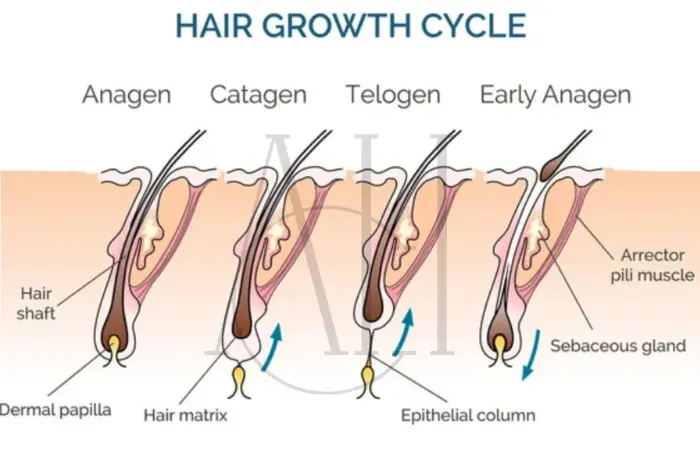
The Hair Growth Cycle and Stress Impact
The normal hair growth cycle consists of three distinct phases: anagen (growth), catagen (transition), and telogen (resting). Stress disrupts this carefully orchestrated cycle, leading to premature entry into the telogen phase and subsequent hair loss.
Understanding how stress affects each phase of the hair growth cycle helps explain the delayed onset of stress-related hair loss and provides insight into recovery timelines.
Normal Hair Growth vs. Stress-Induced Shedding
Under normal circumstances, the hair growth cycle maintains a balanced distribution of follicles across all phases:
- Anagen phase typically lasts 2-7 years, during which hair actively grows
- Catagen phase is a brief 2-3 week transition period
- Telogen phase lasts 2-3 months before hair naturally sheds and the cycle restarts
Stress disrupts this balance by:
- Shortening the anagen phase, reducing overall hair length and density
- Forcing more follicles into telogen phase simultaneously
- Creating a delayed but noticeable increase in hair shedding 2-4 months later
How Long Does Stress-Related Hair Loss Last?
The duration of stress-related hair loss depends on multiple factors including stress severity, duration, and individual recovery capacity:
- Acute stress events typically cause hair loss lasting 3-6 months
- Chronic stress can lead to ongoing hair thinning until stress levels normalize
- Recovery usually begins 2-3 months after stress reduction, with full regrowth taking 6-12 months
What Are the Signs of Stress Hair Loss?
Recognizing the signs of stress hair loss early enables prompt intervention and better outcomes. Stress-related hair loss has characteristic patterns and symptoms that distinguish it from other types of hair loss such as androgenic alopecia.
The key indicators of stress hair loss include timing relative to stressful events, distribution patterns, and associated symptoms that reflect the underlying stress response.
Losing Hair While Washing or Brushing
One of the earliest signs of stress hair loss is increased hair shedding during routine activities:
- Noticing significantly more hair in the shower drain or on your brush
- Hair coming out in larger clumps than usual during gentle manipulation
- Increased hair on pillowcases, clothing, or around the house
Shedding That Lasts 3–6 Months
Stress hair loss typically follows a predictable timeline that helps distinguish it from other conditions:
- Hair loss begins 2-4 months after a major stressful event or period
- Peak shedding usually occurs 3-4 months post-stress
- Gradual improvement typically begins around month 6 if stress has been addressed
Managing Stress to Prevent Hair Loss
Effective stress management represents the cornerstone of preventing and treating stress-related hair loss. By addressing the root cause – elevated stress hormones and their effects on hair follicles – individuals can often prevent hair loss or accelerate recovery.
Stress management strategies should target both immediate stress relief and long-term resilience building to protect against future hair loss episodes.
Effective Ways to Reduce Stress for Healthier Hair
Multiple evidence-based approaches can help reduce stress and protect hair health:
- Regular meditation or mindfulness practices to lower baseline cortisol levels
- Adequate sleep (7-9 hours nightly) to support healthy stress hormone regulation
- Regular physical exercise to metabolize stress hormones and improve mood
Managing Stress to Support Hair Regrowth
Once hair loss has occurred, specific stress management strategies can accelerate recovery:
- Cognitive behavioral therapy to address stress-related thought patterns
- Progressive muscle relaxation techniques to reduce physical tension
- Social support networks to provide emotional buffering during stressful periods
How Can You Prevent Stress-Related Hair Loss?
Prevention of stress-related hair loss requires a multi-faceted approach addressing nutrition, lifestyle factors, and stress management. While some stressful events are unavoidable, building resilience through healthy habits can minimize their impact on hair health.
Proactive prevention strategies focus on supporting optimal hair growth conditions while building the body’s capacity to handle stress without significant hair follicle disruption.
Eat Enough Protein and Vitamins
Nutritional support plays a crucial role in maintaining healthy hair and resilience against stress-induced hair loss:
- Adequate protein intake (0.8-1.2g per kg body weight) provides essential amino acids for hair structure
- B-complex vitamins, particularly biotin and B12, support healthy hair growth cycle function
- Iron, zinc, and vitamin D deficiencies can exacerbate stress-related hair loss
Regular Sleep, Balanced Diet, and Scalp Massage
Lifestyle modifications create optimal conditions for hair health and stress resilience:
- Consistent sleep schedule helps regulate cortisol and other stress hormones
- Anti-inflammatory diet rich in omega-3 fatty acids supports hair follicle health
- Regular scalp massage improves circulation and may stimulate hair growth
Self-Care, Mindfulness, and Exercise
Comprehensive self-care practices build long-term resilience against stress-related hair loss:
- Daily mindfulness or meditation practice to reduce baseline stress levels
- Regular exercise program combining cardiovascular and strength training
- Engaging in enjoyable activities that provide stress relief and emotional support
Manage Stress to Limit Cortisol Effects
Targeted stress management specifically aims to minimize cortisol and other stress hormone elevation:
- Learning stress recognition techniques to identify early warning signs
- Developing healthy coping strategies before stress becomes overwhelming
- Professional counseling or therapy when dealing with chronic stress or trauma
Professional Solutions for Stress Hair Loss
When self-care and stress management alone are insufficient, professional interventions can provide additional support for stress-related hair loss. These solutions range from medical treatments to specialized therapies addressing both the hair loss and underlying stress.
Professional treatment options are particularly valuable for severe hair loss, chronic stress situations, or when multiple factors contribute to hair thinning.
When to Consult a Hair Loss Specialist
Several indicators suggest the need for professional evaluation of stress-related hair loss:
- Hair loss persisting more than 6 months after stress reduction
- Patchy hair loss patterns suggesting alopecia areata or other conditions
- Hair loss accompanied by scalp irritation, scaling, or other concerning symptoms
Advanced Treatments for Stress-Induced Thinning
Medical professionals can offer treatments specifically targeting stress-induced hair thinning:
- Minoxidil application to stimulate hair follicle activity and promote regrowth
- Low-level laser therapy to improve scalp circulation and hair follicle function
- Platelet-rich plasma (PRP) treatments to provide growth factors supporting hair regeneration
Combining Therapy and Hair Restoration for Best Results
Comprehensive treatment approaches address both psychological and physical aspects of stress-related hair loss:
- Cognitive behavioral therapy to develop better stress management skills
- Nutritional counseling to optimize dietary support for hair health
- Coordinated care between mental health professionals and hair restoration specialists
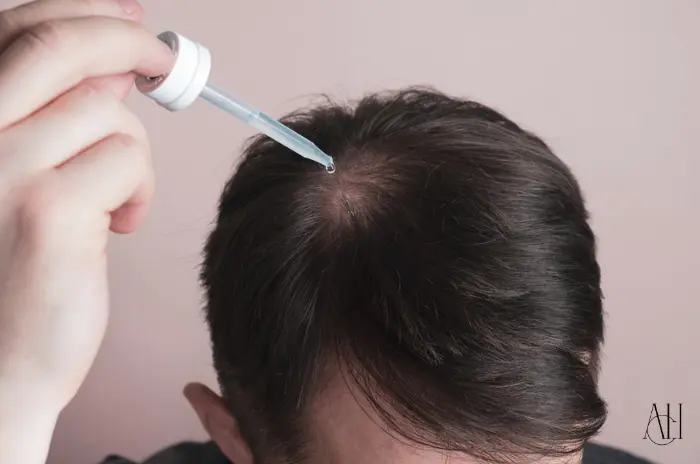
Could Stress Harm Human Hair Growth?
While much research on stress and hair loss has been conducted in animal models, emerging evidence suggests similar mechanisms operate in humans. The biological pathways identified in laboratory studies appear to translate to human hair follicle function and stress hormone responses.
Understanding the relevance of animal research to human hair loss helps inform treatment approaches and research directions for stress-related hair loss in clinical settings.
Similar Hormones in Humans
Human stress hormone systems share fundamental similarities with animal models used in hair loss research:
- Cortisol in humans functions similarly to corticosterone in laboratory animals
- Hair follicle stem cells in humans respond to hormonal signals in comparable ways
- The basic hair growth cycle structure is conserved across mammalian species
What Research Needs to Confirm
While animal studies provide valuable insights, human-specific research remains essential:
- Clinical trials specifically examining stress management interventions for hair loss
- Long-term studies tracking hair growth recovery after stress reduction
- Investigation of individual variations in stress hormone sensitivity and hair loss patterns
The Biological Link Between Stress and Hair Loss
The fundamental biological connection between stress and hair loss involves disruption of cellular communication pathways essential for healthy hair follicle function. This disruption occurs at the molecular level, affecting how hair follicle stem cells receive and respond to growth signals.
Recent scientific advances have identified specific molecular targets where stress hormones interfere with normal hair regeneration processes, providing new insights into treatment possibilities.
How Stress Halts Hair Regeneration
Stress hormones interrupt hair regeneration through multiple interconnected mechanisms:
- Cortisol binding to receptors in dermal papilla cells disrupts normal signaling cascades
- Reduced production of growth factors necessary for hair follicle stem cell activation
- Inflammatory responses triggered by chronic stress further impair hair follicle function
Why Stress Doesn’t Always Cause Immediate Hair Loss
The delayed onset of stress-related hair loss reflects the timeline of hair growth cycle disruption:
- Hair currently in the anagen (growth) phase continues growing despite stress hormone exposure
- Stress affects the transition into the next growth cycle rather than immediately stopping growth
- Visible hair loss appears only when affected follicles complete their growth cycle and shed
The Science Behind Stress and Hair Loss
Scientific understanding of stress-related hair loss has advanced significantly with the identification of specific molecular mechanisms linking stress hormones to hair follicle dysfunction. These discoveries explain both the delayed onset and potential reversibility of stress-induced hair loss.
The research reveals why some individuals are more susceptible to stress-related hair loss and provides targets for therapeutic intervention.
How Stress Hormones Disrupt Your Hair Growth Cycle
Stress hormones interfere with the hair growth cycle through multiple pathways:
- Cortisol elevation reduces the duration of the anagen (growth) phase
- Stress hormone receptors in hair follicles become oversensitive with chronic stress
- Disrupted circadian rhythms from stress affect the timing of hair growth cycle transitions
Why Hair Falls Out Weeks/Months After a Stressful Event
The timeline of stress-related hair loss reflects the biology of hair follicle responses:
- Stress hormones affect follicles preparing to enter new growth cycles
- Hair currently growing continues for weeks until reaching its programmed end point
- The cumulative effect becomes visible only when multiple affected follicles shed simultaneously
Stress Hair Loss vs Other Hair Loss Types
Distinguishing stress-related hair loss from other forms of hair loss requires understanding the characteristic patterns, timing, and associated factors of each condition. This differentiation is crucial for selecting appropriate treatments and setting realistic expectations.
Pattern baldness, medical conditions, and stress-induced hair loss each have distinct presentations that help guide diagnosis and treatment decisions.
How to Tell Stress Hair Loss From Male/Female Pattern Baldness
Several key differences distinguish stress hair loss from androgenic alopecia (pattern baldness):
- Stress hair loss typically causes diffuse thinning across the entire scalp rather than specific patterns
- Pattern baldness follows predictable patterns (receding hairlines, crown thinning) while stress hair loss is more uniform
- Stress-related hair loss often has a clear temporal relationship to stressful events or periods
| Stress Hair Loss | Pattern Baldness (Androgenic Alopecia) |
|---|---|
| Diffuse thinning across entire scalp | Specific patterns (temples, crown, vertex) |
| Sudden onset 2-4 months after stress | Gradual progression over years |
| Usually temporary and reversible | Progressive and permanent without treatment |
| Affects men and women equally | More common in men, different patterns in women |
| Hair texture remains normal | Hair becomes finer and shorter over time |
| No family history required | Strong genetic/family history component |
| Cortisol and stress hormone related | DHT (dihydrotestosterone) hormone related |
| Recovery possible with stress management | Requires medical treatments (minoxidil, finasteride) |
Other Medical Conditions That Can Mimic Stress Hair Loss
Various medical conditions can produce hair loss patterns similar to stress-induced thinning:
- Thyroid disorders can cause diffuse hair thinning similar to telogen effluvium
- Autoimmune conditions may trigger both stress responses and direct hair loss
- Nutritional deficiencies often coexist with stress and contribute to hair loss
What Happens to Hair Follicles Under Stress
Hair follicles under stress undergo specific cellular changes that disrupt their normal regenerative capacity. These changes occur at the level of hair follicle stem cells and the supportive dermal papilla cells that regulate hair growth.
Understanding these cellular-level changes helps explain why stress-related hair loss can persist even after stress levels normalize and why recovery takes time.
Dermal Papilla Stops Producing GAS6 Signal
The GAS6 signaling pathway represents a critical link between stress and hair follicle dysfunction:
- Stress hormones suppress GAS6 production in dermal papilla cells
- Without GAS6 signals, hair follicle stem cells remain in a quiescent state
- This mechanism explains how chronic stress can prevent new hair growth even without active shedding
Hair Follicle Stem Cells Remain Inactive
Hair follicle stem cells require specific signals to activate and begin new hair growth cycles:
- Stress hormones maintain stem cells in an inactive state longer than normal
- The stem cell niche environment becomes less conducive to activation under chronic stress
- Recovery requires both stress hormone normalization and restoration of proper signaling
How Long Does Stress Hair Loss Last?
The duration of stress-related hair loss varies depending on stress severity, individual factors, and intervention timing. Understanding typical recovery timelines helps set realistic expectations and maintain motivation during the healing process.
Recovery from stress-induced hair loss generally follows predictable patterns, though individual variation is common.
Regrowth Usually Begins in 2–3 Months
Most individuals experience the beginning of hair recovery within a few months of stress reduction:
- New hair growth typically becomes noticeable 2-3 months after stress levels normalize
- Initial regrowth may appear finer or different in texture than original hair
- Full restoration of hair density usually requires 6-12 months of consistent recovery
Heartbreak May Require 7–8 Months to Recover
Severe emotional trauma, such as relationship loss, often requires extended recovery periods:
- Intense emotional stress can cause more severe hair follicle disruption
- The psychological impact may maintain elevated stress hormones longer
- Complete recovery may take 8-12 months or longer depending on emotional healing
When Should You Talk to a Doctor?
Medical consultation becomes important when stress-related hair loss doesn’t follow typical patterns or when other concerning symptoms accompany the hair loss. Early professional evaluation can help rule out other conditions and optimize treatment outcomes.
Certain warning signs indicate the need for prompt medical attention rather than continued self-management.
Noticing Sudden or Patchy Hair Loss
Specific patterns of hair loss warrant immediate medical evaluation:
- Sudden hair loss occurring over days or weeks rather than months
- Patchy hair loss in circular or irregular patterns suggesting alopecia areata
- Hair loss accompanied by scalp tenderness, scaling, or inflammation
Checking for Other Medical Issues
Medical evaluation helps identify underlying conditions that may contribute to or mimic stress-related hair loss:
- Blood tests to check for thyroid disorders, nutritional deficiencies, or hormonal imbalances
- Scalp examination to rule out dermatological conditions
- Assessment of medications or supplements that might contribute to hair loss
FAQ : Stress-Related Hair Loss
How does stress actually cause hair loss on a biological level?
tress triggers the release of cortisol and other stress hormones that disrupt the normal hair growth cycle by forcing hair follicles into a premature resting phase and inhibiting hair follicle stem cell activation.
What are the specific types of hair loss that can be triggered by stress?
The three main types are telogen effluvium (diffuse thinning), alopecia areata (patchy hair loss), and trichotillomania (compulsive hair pulling), each with distinct patterns and mechanisms.
How long after a stressful event can I expect to see hair loss, and how long does it typically last?
Stress-related hair loss typically appears 2-4 months after the stressful event and can last 3-6 months, with regrowth usually beginning 2-3 months after stress reduction.
What are the common signs and symptoms of stress-related hair loss?
Common signs include increased hair shedding during washing or brushing, diffuse thinning across the scalp, and hair loss that correlates with recent stressful periods or events.
Can stress-induced hair loss be prevented, and what are effective ways to manage stress for healthier hair?
Yes, through regular exercise, adequate sleep, proper nutrition, mindfulness practices, and developing healthy stress management techniques before stress becomes overwhelming.
How can I differentiate stress-related hair loss from other types of hair loss, such as male or female pattern baldness?
Stress hair loss typically causes diffuse thinning rather than specific patterns, has a clear relationship to stressful events, and often affects the entire scalp uniformly.
When should I consider consulting a hair loss specialist or doctor for stress-related hair loss?
Consult a professional if hair loss persists beyond 6 months, involves patchy patterns, includes scalp symptoms, or doesn’t correlate with identifiable stressful events.
Are there professional solutions or advanced treatments available for stress-induced hair thinning?
Yes, including minoxidil treatments, low-level laser therapy, PRP treatments, and comprehensive approaches combining stress management therapy with hair restoration techniques.

